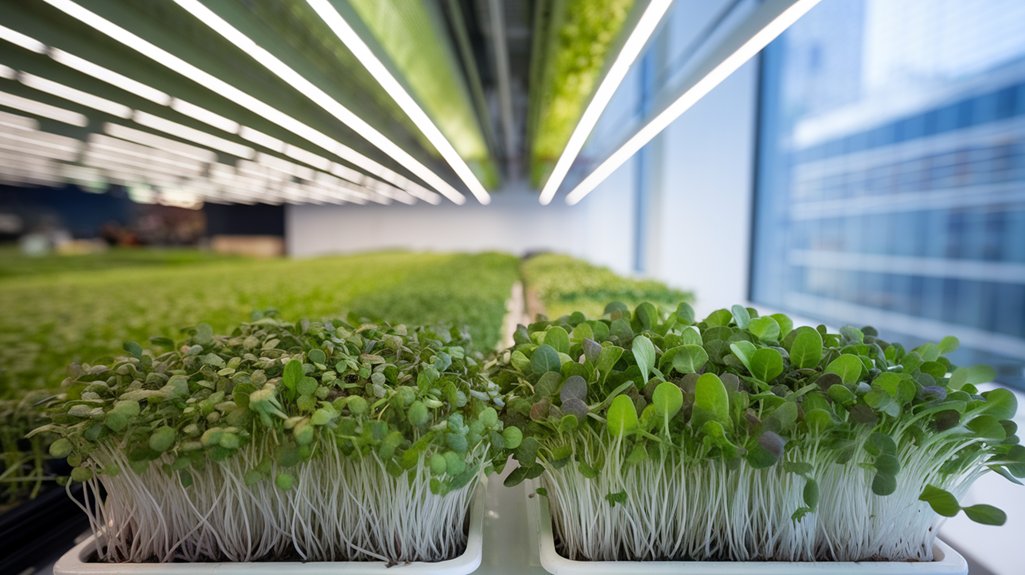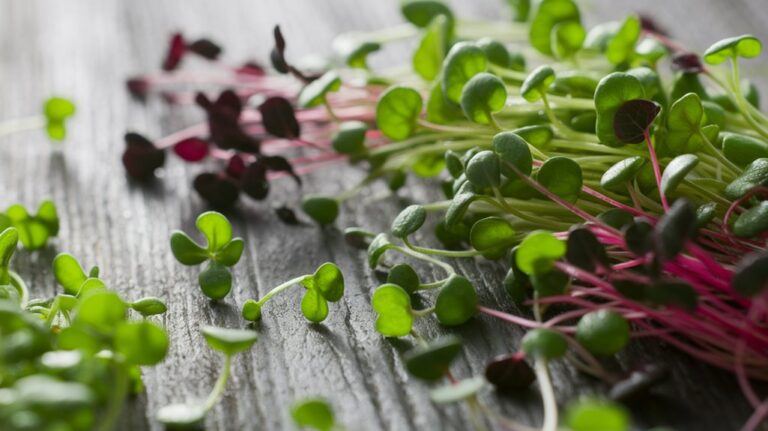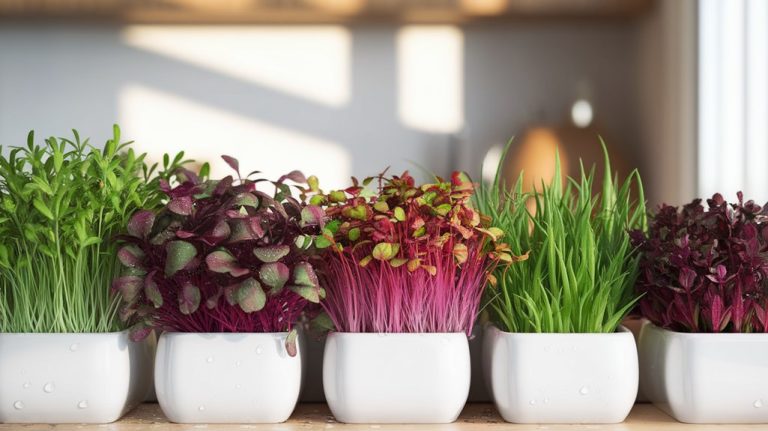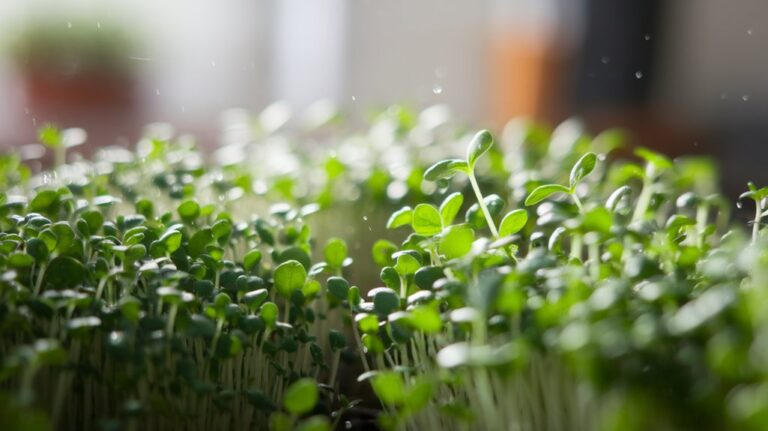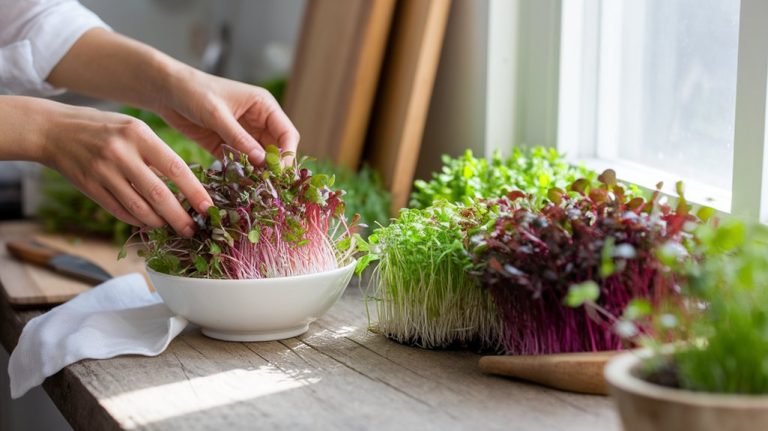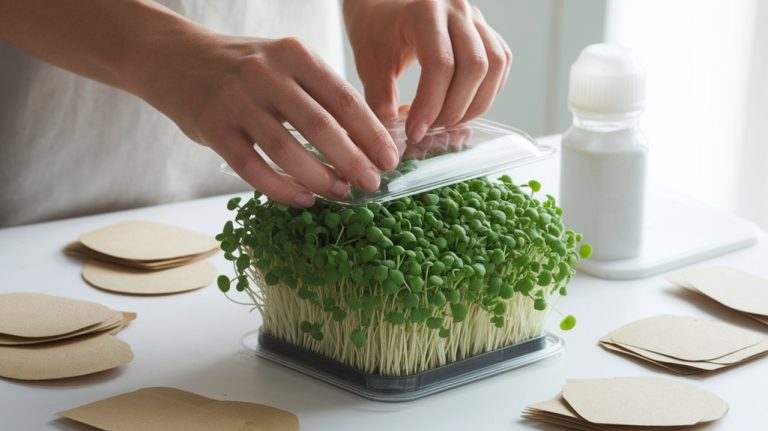Why Microgreens Are the Future of Urban Gardening
Microgreens are the future of urban gardening because they’re incredibly nutrient-dense, offering up to 40 times more nutrients than mature plants. They thrive in small spaces, making them perfect for city living, and grow quickly, maturing within just 7 to 14 days. Not only do they enhance flavors in dishes, but they’re also environmentally friendly, using significantly less water. If you’re curious about which varieties to start with, there’s much more to explore.
Key Takeaways
- Microgreens thrive in limited spaces, making them ideal for urban gardening in small apartments and balconies.
- Their rapid growth cycle allows for quick harvesting, providing fresh produce in just 7 to 14 days.
- They require significantly less water and resources, promoting sustainable gardening practices in urban environments.
- High nutrient density enhances meal quality, making microgreens a smart choice for health-conscious urban dwellers.
- Their culinary versatility elevates dishes, appealing to urban chefs and home cooks alike.
The Nutritional Powerhouse of Microgreens
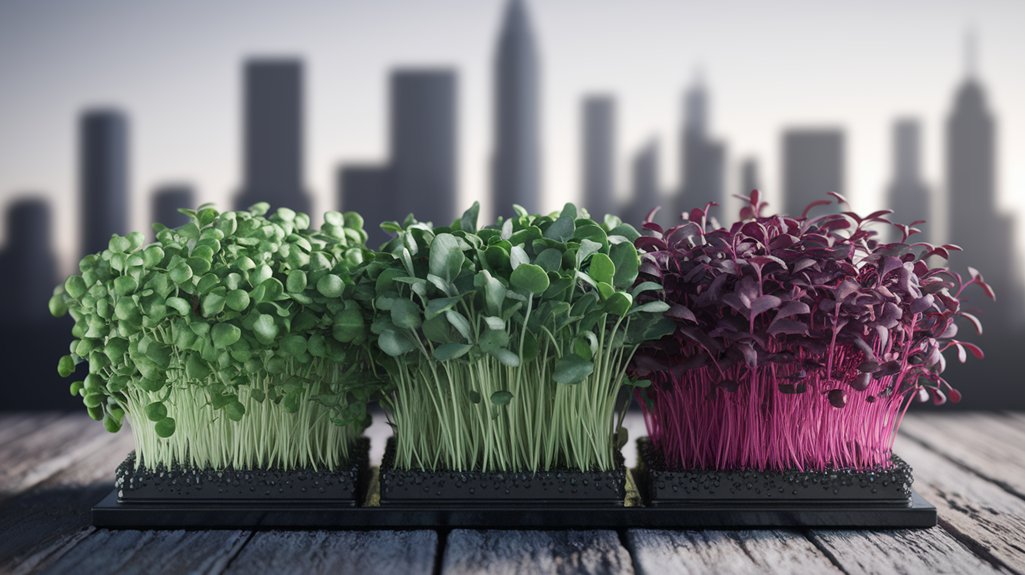
Microgreens are often overlooked, but they pack a serious nutritional punch. I’ve researched various studies, and it’s clear that these tiny greens can contain up to 40 times more nutrients than their mature counterparts.
For instance, a study published in the Journal of Agricultural and Food Chemistry found that microgreens possess substantial levels of vitamins C, E, and K, as well as essential minerals. They’re also rich in antioxidants, which can combat oxidative stress in the body.
Incorporating just a handful of microgreens into meals not only enhances flavor but also boosts overall health. This nutrient density makes them an ideal addition to any diet, especially for those of us seeking to maximize nutritional intake without increasing calorie consumption.
Space-Saving Solutions for Urban Dwellers
In urban environments, where space is often limited, finding effective ways to garden can feel daunting. However, microgreens offer a practical solution. These small, nutrient-dense plants can thrive in minimal space, requiring only a small tray or even a windowsill.
Vertical gardening is another technique I’ve found useful; stacking planters or utilizing wall-mounted systems maximizes growing area while keeping the footprint small. Hydroponic systems, which don’t require soil, also optimize space and can be set up indoors.
Utilizing shelves or repurposed furniture for plant storage allows me to integrate gardening into my living space seamlessly. By employing these space-saving solutions, I’ve transformed even the tiniest of apartments into vibrant, productive gardens, proving that urban gardening is both achievable and rewarding.
Quick Growth Cycle: From Seed to Plate
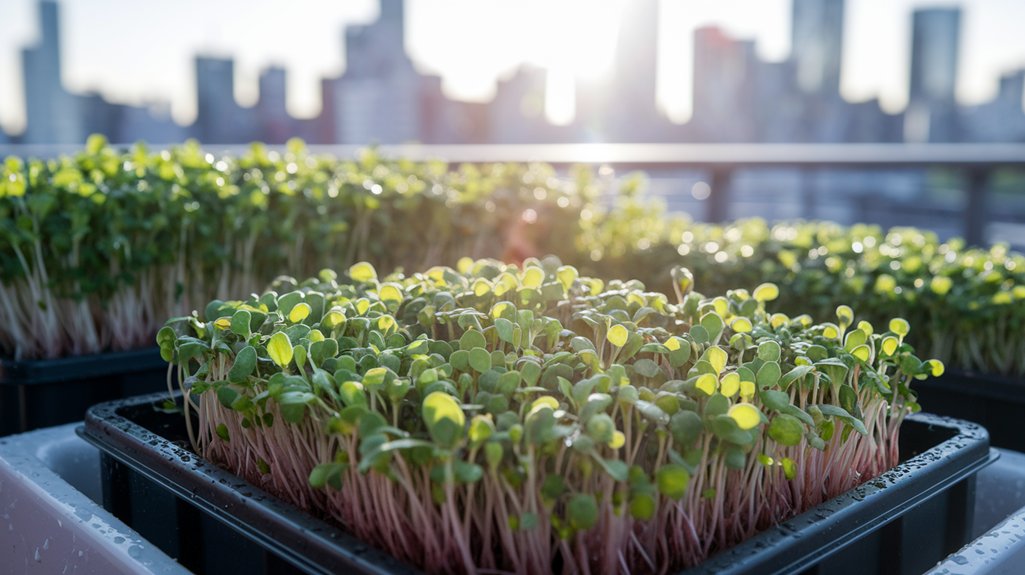
When I grow microgreens, I’m always amazed by their rapid germination process, which can take just a few days.
Within weeks, I can harvest these nutrient-dense plants, bringing fresh flavors and health benefits straight to my plate.
This quick growth cycle makes microgreens an ideal choice for urban gardening, maximizing both space and time.
Rapid Germination Process
Although many gardeners may overlook the potential of microgreens, I find their rapid germination process fascinating and highly efficient.
Microgreens typically sprout within 5 to 14 days, depending on the variety and environmental conditions. Their small seed size and optimal moisture levels accelerate this process, allowing them to germinate quickly.
Research shows that microgreens utilize less energy during germination compared to larger plants, as they rely on the nutrients stored in their seeds. This efficiency not only shortens the time to harvest but also makes them ideal for urban gardening, where space is often limited.
Harvesting in Weeks
Microgreens not only germinate rapidly but also offer a quick growth cycle that allows for harvesting within weeks. Typically, I find that most varieties, like radish and arugula, can be harvested just 7 to 14 days after sowing.
This swift turnaround is due to their small seed size and high germination rates, which contribute to efficient nutrient uptake. I’ve noticed that optimal light conditions and proper watering further accelerate their growth.
Research shows that microgreens reach maturity faster than traditional crops, making them ideal for urban gardening where space and time are limited.
With minimal investment in equipment and resources, I can enjoy fresh greens on my plate in no time, transforming my meals into vibrant, flavorful experiences.
Nutrient Density Boost
While cultivating microgreens, I’ve discovered that their rapid growth cycle not only allows for quick harvests but also significantly enhances their nutrient density. Research indicates that microgreens, harvested just 7 to 21 days post-sowing, contain higher concentrations of vitamins, minerals, and antioxidants compared to their mature counterparts. For example, studies show that some varieties can have up to 40 times more nutrients.
Here’s a quick comparison of selected microgreens:
| Microgreen | Nutrient Highlight | Growth Time |
|---|---|---|
| Broccoli | Sulforaphane | 7 days |
| Radish | Vitamin C | 10 days |
| Sunflower | Vitamin E | 14 days |
These impressive figures underscore why microgreens are an ideal choice for urban gardening enthusiasts.
Enhancing Flavor Profiles in Culinary Dishes
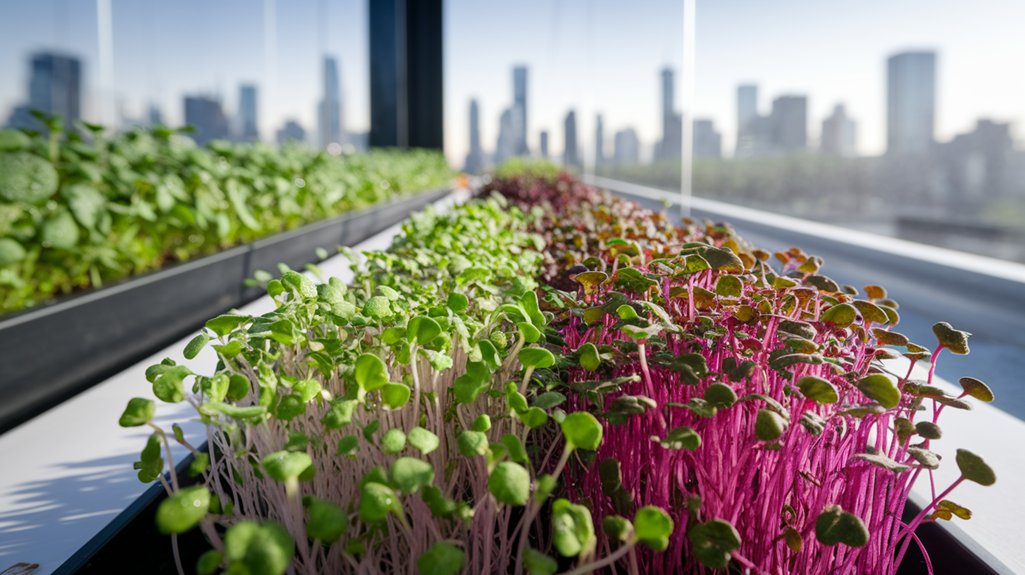
When I experiment with culinary dishes, I find that incorporating microgreens can significantly elevate their flavor profiles. These tiny greens pack concentrated flavors that amplify the taste of various meals.
For instance, basil microgreens offer a vibrant burst of sweetness, while radish microgreens add a peppery kick. Research shows that microgreens contain higher levels of essential oils and phytochemicals, which contribute to their intense flavors. This makes them an ideal garnish or ingredient in salads, soups, and sandwiches.
Furthermore, their diverse range—like mustard, beet, and pea shoots—allows for creativity in flavor combinations. By integrating microgreens, I can enhance not just the taste but also the visual appeal of my dishes, providing a gourmet experience without extensive culinary training.
Environmental Benefits of Growing Microgreens
Incorporating microgreens into my culinary creations not only enhances flavor but also offers significant environmental benefits. These tiny plants require minimal resources, making them ideal for urban gardening. For instance, they use less water and land compared to traditional crops, while also absorbing carbon dioxide and producing oxygen effectively.
Here’s a quick comparison to highlight their advantages:
| Aspect | Microgreens |
|---|---|
| Water Usage | 90% less than mature plants |
| Growing Space | Requires only a few square feet |
| Carbon Sequestration | High efficiency due to rapid growth |
Easy-to-Grow Varieties for Beginners
When starting out with microgreens, I recommend focusing on varieties that germinate quickly, such as radishes and mustard greens.
These nutrient-rich leafy greens not only offer health benefits but also add vibrant flavors to various dishes. Their versatility in culinary uses makes them perfect for beginners looking to enhance their meals effortlessly.
Quick Germination Times
Choosing microgreens with quick germination times can significantly enhance your urban gardening experience, especially for beginners eager to see results. Fast-growing varieties not only build confidence but also provide a steady supply of fresh greens. Here’s a quick reference table of some easy-to-grow microgreens:
| Microgreen | Germination Time |
|---|---|
| Radish | 5-7 days |
| Arugula | 5-10 days |
| Broccoli | 5-7 days |
| Pea Shoots | 7-14 days |
| Mustard Greens | 5-10 days |
Starting with these varieties helps ensure quicker harvests, keeping your urban gardening journey engaging and rewarding. You’ll be amazed at how little time it takes to grow your own nutrient-dense greens!
Nutrient-Rich Leafy Greens
After you’ve enjoyed the quick results from fast-germinating microgreens, exploring nutrient-rich leafy greens can further enrich your urban gardening repertoire.
Varieties like spinach, kale, and Swiss chard aren’t only easy to grow but also packed with essential vitamins and minerals. Spinach, for instance, boasts high levels of iron and vitamin K, while kale is renowned for its antioxidants.
I recommend starting with seeds, as they germinate quickly and can thrive in small spaces. These leafy greens prefer cooler temperatures and can be grown indoors or outdoors.
Versatile Culinary Uses
While many may think of microgreens as mere garnishes, I’ve found that their versatility in the kitchen makes them a fantastic addition to any meal. These tiny greens pack a punch, both in flavor and nutrition.
For beginners, I recommend starting with easy-to-grow varieties like radish, arugula, and pea shoots. Radish microgreens add a peppery kick to salads, while arugula enhances dishes with its nutty flavor. Pea shoots, with their sweet taste, complement stir-fries and sandwiches beautifully.
Research shows that microgreens can contain up to 40 times the nutrients of their mature counterparts, making them a powerful ingredient. Incorporating microgreens into your meals not only elevates the flavor but also boosts your overall nutrient intake effortlessly.
Frequently Asked Questions
How Do I Store Microgreens After Harvesting?
After I harvest my microgreens, I always store them properly to maintain freshness.
I rinse them gently with cool water, then pat them dry with a paper towel.
I place them in a breathable container, like a clamshell or a paper bag, and keep them in the refrigerator.
This way, they stay crisp for about a week.
I find that avoiding moisture buildup is crucial for preventing spoilage and maintaining flavor.
Can Microgreens Be Grown Indoors Year-Round?
Absolutely, I grow microgreens indoors year-round. They thrive in controlled environments, requiring just a few essentials: light, temperature, and moisture.
I use LED grow lights to simulate sunlight, keeping them on for about 12-16 hours daily. I maintain a temperature between 60-75°F, ensuring they get enough water without becoming waterlogged.
With proper attention, I enjoy fresh, nutrient-dense microgreens regardless of the season. It’s a rewarding and sustainable endeavor!
What Tools Do I Need to Grow Microgreens?
To grow microgreens effectively, I’ve found a few essential tools make a big difference.
You’ll need seed trays or shallow containers, quality potting soil, and a spray bottle for watering.
A grow light helps if you lack natural sunlight. Additionally, a humidity dome can maintain moisture during germination.
With these tools, I’ve successfully cultivated various microgreens, ensuring they thrive and deliver maximum flavor and nutrition in my urban gardening efforts.
Are There Any Pests That Affect Microgreens?
Yes, microgreens can attract pests, though they’re generally less susceptible than larger plants.
I’ve encountered aphids, fungus gnats, and spider mites in my own experiences. Maintaining proper airflow and moisture levels helps minimize infestations.
If you spot pests, I recommend using insecticidal soap or neem oil as a natural remedy.
Regularly inspecting your crops is crucial; catching issues early can save your harvest from significant damage.
How Do I Incorporate Microgreens Into My Diet?
Incorporating microgreens into my diet is simple and rewarding. I sprinkle them on salads for an added crunch and nutrient boost.
I love adding them to smoothies for a vibrant color and health kick. They also enhance sandwiches and wraps, bringing fresh flavors.
When I make omelets or soups, I toss in a handful just before serving. Microgreens are versatile, and I find they elevate almost any dish I prepare.
Conclusion
In conclusion, microgreens are more than just a trendy garnish; they’re a sustainable solution for urban gardening. With their impressive nutritional profile, space efficiency, and rapid growth rates, they offer a practical way to enhance our diets. Moreover, their environmental benefits contribute to a healthier planet. For anyone looking to start gardening, microgreens provide an accessible entry point that promises both culinary delight and personal satisfaction. Embracing them could truly reshape our urban food landscapes.

